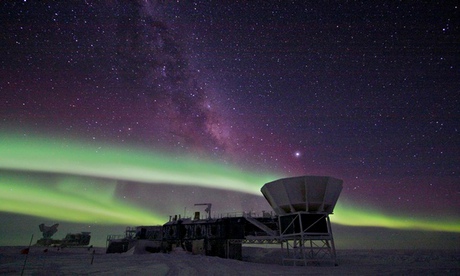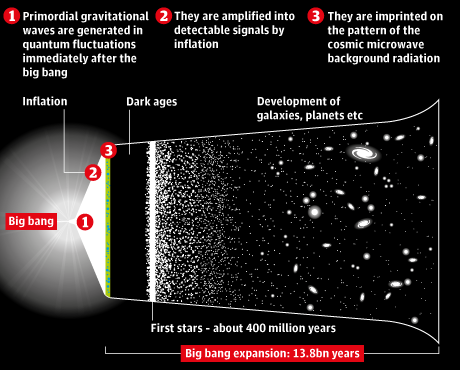Primordial gravitational wave discovery heralds 'whole new era' in physics
 |
| Scientists detected telltale signs of gravitational waves using the Bicep2 telescope (far left) at the south pole. Photograph: Lindsey Bleem/South Pole Telescope blog |
Scientists have heralded a "whole new era" in physics with the detection of "primordial gravitational waves" – the first tremors of the big bang.
The minuscule ripples in space-time are the last prediction of Albert Einstein's 1916 general theory of relativity to be verified. Until now, there has only been circumstantial evidence of their existence. The discovery also provides a deep connection between general relativity and quantum mechanics, another central pillar of physics.
"This is a genuine breakthrough," says Andrew Pontzen, a cosmologist from University College London who was not involved in the work. "It represents a whole new era in cosmology and physics as well." If the discovery is confirmed, it will almost certainly lead to a Nobel Prize.
The detection, which has yet to be published in a peer-reviewed scientific journal, was announced on Monday at the Harvard-Smithsonian Center for Astrophysics in Cambridge, Massachusetts, and comes from the Background Imaging of Cosmic Extragalactic Polarization 2 (Bicep2) experiment – a telescope at the South Pole.
The detection also provides the first direct evidence for a long-held hypothesis called inflation. This states that a fraction of a second after the big bang, the universe was driven to expand hugely. Without this sudden growth spurt, the gravitational waves would not have been amplified enough to be visible.
"Detecting this signal is one of the most important goals in cosmology today. A lot of work by a lot of people has led up to this point," said John Kovac of the Harvard-Smithsonian Center for Astrophysics, who leads the BICEP2 collaboration.
The primordial gravitational waves were visible because they created a twisting pattern called polarisation in light from the big bang. Polarisation is the direction in which a light wave oscillates. It is invisible to human eyes, which only register brightness and colour. Sunglasses made from polaroid sheets work by blocking out all light waves except those with a specific polarisation.
Light from the big bang has been turned into microwaves by its passage across space. These microwaves were discovered in 1964 and are known as the cosmic microwave background radiation. Bicep2 was designed to measure their polarisation.
Rumours began on Friday that the detection of primordial gravitational waves would be announced. It had been thought that a gravitational wave signal would have to be surprisingly strong to be detected by the current technology used in ground-based detectors.
The Bicep2 team have spent three years analysing the signal in order to be certain. "This has been like looking for a needle in a haystack, but instead we found a crowbar," said co-leader Clem Pryke of the University of Minnesota.
Nevertheless, the signal will have to be confirmed. "I think a lot of people will be looking very critically at this," says Pontzen.
Confirmation could come as early as August. The European Space Agency's Planck satellite has been looking for this same signal and is due to announce its findings.
Whereas Bicep2 has only looked at part of the sky visible from the south pole, Planck has mapped the whole sky.
If it confirms the signal and its strength then cosmologists will be presented with an extraordinarily rich seam of data about the conditions immediately after the big bang. "We are going to be able to measure all sorts of subtle details to start pinning down how physics operates in those utterly extreme conditions," says Pontzen.
This could reveal the interface between the two great theories of physics: general relativity and quantum mechanics. Despite almost a century of effort, the world's physicists have not been able to show how these theories work together. The primordial gravitational waves that produced the signal seen by Bicep2 were produced in interactions that took place at a trillion times the energies that can be produced in the Large Hadron Collider at Cern.
"This is like turning the whole universe into a particle physics experiment," said Hiranya Peiris, a cosmologist from University College London.
It could even show them the way to join the two theories together, producing what is sometimes called "the theory of everything".
"Gravitational waves emitted at the time of the big bang can tell us how the universe came to exist," said Dr Ed Daw, an astronomer at the University of Sheffield. "If these results prove correct, we will have new key information on the very early universe, information that is hard to get from any other source.
"Gravitational waves are a new frontier in astrophysics and cosmology. If today's findings are accurate then it will further strengthen our understanding of how the universe formed."
The signal detected by Bicep2 is not easy to see because it is masked by distortions caused by the light's passage through clusters of galaxies, and through dust clouds in the Milky Way. These distortions must be carefully stripped away before the primordial signal can be revealed.
"They have thought very carefully about how to remove the experimental and other contaminating effects. They are a very experienced team and this is the real deal but it doesn't mean that they are necessarily right," said Daw.
Some subtle contamination may yet be affecting their data. The only way to know for sure is to have other telescopes and spacecraft see the signal too.
There is already a minor disagreement. Last year the European Space Agency published preliminary results from its Planck satellite. They were based on data that measured temperature rather than polarisation, but close examination reveals that they are not a smooth fit with the results announced by Bicep2.
"It's not completely incompatible but it does raise questions. It needs thinking about in a calm way," said Pontzen.
Taken at face value, however, these new results mean that cosmologists can now begin to tease out the details of the big bang. The term inflation is used to represent a class of models that each have different attributes and effects on the universe. The strength and the pattern of the gravitational wave signal will be used to tell cosmologists about which inflationary models are the correct ones.
Although no cosmologist truly doubts the existence of gravitational waves nothing like today's announcement has ever been seen before. "This is a different kettle of fish entirely. We are talking about the fingerprint of the big bang in gravitational waves on the whole universe," said Daw.
Found here http://www.theguardian.com/science/2014/mar/17/primordial-gravitational-wave-discovery-physics-bicep
